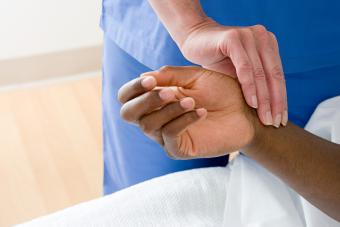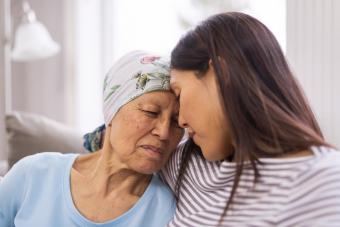
Dying is a shutting down of the body's physical, sensory, and mental functions, and it happens in stages. This process can take minutes or months, depending on what is going on inside the person's body. When you are with a person who is about to die, it is good to know the physical signs of dying so you can understand what is happening.
What Are the Stages of Dying?
There are specific signs your body is shutting down that may occur during the active stages of dying that indicate that the end of life is near. While not everyone experiences all of these steps of dying, many are common. It's also important to note that these physical symptoms do not happen in a specific order.
Body System Shutdown
The body shuts down as the end gets closer. The heart doesn't pump normally which leads to lower blood pressure and less blood going to the arms and legs and other organs like the kidneys. With less blood going to the kidneys, the kidneys stop working which leads to smaller amounts of urine output. The urine may also become darker in color.
Less blood goes to the brain which may also contribute to mental changes as death nears.

Confusion
Some people may become confused as death nears. They may become agitated and may need to be restrained. They may also become disoriented and not know where they are or what time or day it is. Not being able to recognize family members may also be a symptom of this state of confusion as well. Others may have hallucinations.
The confusion may be caused by several things like chemical imbalances in the body, kidney failure, infection, or reduced blood flow to the brain.
Decreased Level of Consciousness
As death approaches, the person may go in and out of consciousness where it takes significant effort to wake the person up. The person may even appear to be in a coma and cannot be woken up at all. The dying person may still be able to hear even if he or she is in a coma.
Changes in Circulation to Extremities
The blood pressure drops during this phase. The extremities become cool as the blood stops circulating to them and the person may note that their hands and feet feel numb. It is difficult to know the lowest blood pressure before death because blood pressure varies so much from person to person.
Changes in Skin Color
As the heart rate and blood pressure decreases, the skin of the patient may become paler and the skin may become mottled. The fingernail beds may become darker and less pink than before.

Breathing Changes
Breathing patterns often change in the dying person. Instead of regular deep breaths, the person's breathing is irregular with long breaths followed by shallow ones. The rate of breathing is uneven as well with periods of rapid breathing alternating with slower breaths. Some people develop a Cheyne-Stokes breathing pattern with rapid breaths followed by no breaths at all. There may also be an increase in secretions and mucus in the respiratory tract because the patient cannot clear them out. At the end, this may lead to what is known as a death rattle which is the name given to the noise that these secretions make.
Less Movement
Due to weakness and/or fatigue, the person may not move around much in bed. This could lead to joint pain and stiffness.
Loss of Appetite
In the last hours of life, appetite is decreased and the person does not eat or drink very much. Some of the medications that people take during the last stages of a terminal disease - like opioid pain medications - can lead to nausea and/or vomiting which may contribute to the lack of appetite. The person may not be physically able to swallow any food or drink either.
Reduction in fluid intake may also contribute to the decrease in urine output.
Incontinence
Another sign is incontinence - either bladder or bowel - especially in a person who was not incontinent before. As death approaches, the body loses control of the bladder and bowel functions; this may happen because of the disease that is causing death or because of overall weakness.
Watching the Phases of Dying
Those in the room with a dying person must take some precautions. Knowing that your loved one is going to die is never easy, even if he has been suffering and is ready to pass. While the process of death is natural, just as the process of birth, still being prepared is important.

Dying in Hospice
If the patient is at home with hospice care or at a hospice itself, morphine may be administered to ease any pain. The same will be provided if the death occurs at a hospital or other health care facility.
Who to Contact
If death occurs at home, you will have to contact the appropriate people about removing the body of your loved one. It is important to be aware of those details beforehand, because you may not be in the best state of mind to hunt for information. You also don't want to violate any regulations or laws.
Make Sure People Understand the Final Plan
It is also important to make sure everyone understands the final plan. If someone calls EMS or 911, the paramedics may be required to try to revive the patient - even if that is not what the person or the family wants. This could confuse the situation and cause additional stress. Knowing who to contact is important at the end of life.

Recognizing the Final Stages of Dying
The process of dying tends to come in distinct stages, although there can be some variance depending on the cause of death. There will also be some difference in symptoms depending on the age of the person dying. As death gets closer, physical and emotional symptoms may become more intense, or sometimes suddenly stop briefly right before passing away.
Emotional Symptoms
Someone who is near death may want to tie up loose ends, reflect on their life and feel a range of different emotions. These may include:
- Anger about the loss of control they may feel over the process
- Symptoms of depression and anxiety
- Nervous about end-of-life quality of treatment
- Fear about what dying may feel like and wondering what happens after death
- Feelings of sadness about leaving loved ones behind and confronting past regrets
- Comfort in finding meaning and feelings of closure
- Emotionally withdrawing from others
Physical Symptoms
Physical symptoms of dying will vary from person to person, but there are several signs to look out for as someone becomes closer to death. These include:
- Feeling exhausted and wanting to rest
- Having a hard time breathing
- Experiencing physical pain ranging from mild to extreme
- Some may feel nauseous and lose their appetite
End of Life Timeline
A timeline can help you better understand the dying process from months out to right before death occurs. It can lend a small amount of comfort to have an idea of how much longer your loved one may be around for. Keep in mind that this timeline will not apply to everyone and in some circumstances your loved one could exhibit signs that indicate that death is very near, but go on to live a bit longer than anticipated.
- A few months before dying: Your loved one may consume less, sleep more, and reduce physical activity in general
- A few weeks before dying: Feelings of haziness and confusion, temperature fluctuations, clammy skin, and changes in sleeping
- Days to hours before dying: Skin may become blue, may moan from pain, may experience more pain, decrease in body temperature, gasping and difficulty breathing (death rattle), and an irregular, weaker heart rate
- Death: No pulse or detectable heartbeat, and no longer breathing,
Those Left Behind
Understanding the final physical stages of dying does not mean that you will not still feel pain after the death. The friends and family members who have lost a loved one often go through stages of grief as they deal with bereavement. Be sure to get the support and care you need if you have just lost a loved one. Utilize available resources like support groups or other family members to help you process your loss.







